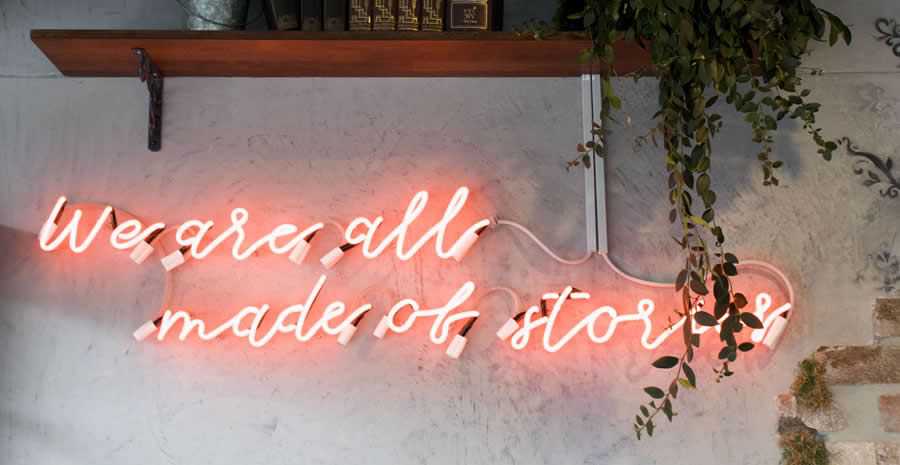Several years ago, I worked as an in-house copywriter and designer for a prominent marketing firm. When I first applied for the job I didn’t have any of the credentials my employers were looking for, and yet I got the job anyway, out of a pool of more qualified competitors. Why did I get chosen? The boss liked my story.
I had no experience with working at a firm, nor was I technical enough to get deeply involved in the backend work. But my cover letter told them that I would be able to communicate clearly and effectively with their customers, while at the same time putting them at ease and perhaps making them laugh a little. I am pretty funny, after all.
The stories we tell prospective employers have a dramatic impact on whether or not we will be successful at what we do. They can literally make or break your career, so it’s important to choose and develop them wisely.
What is Storytelling?
You may be thinking to yourself, ‘I’m a designer – why do I need to worry about telling stories?‘ But storytelling is more than literally sitting down and writing a tale of heroics or romance or wizards who speak Latin.
We encounter storytelling in everyday aspects of our lives, like when we see a man pull a dog out of a busy intersection, or when we watch a group of protesters march by, carrying hand-painted signs for a cause they believe in. All of these things are stories; they’re tiny moments of people taking action and affecting the world around them. Because at the heart of it, that’s all a story really is.
I’ll bet that every movie you’ve ever seen goes something like this: there’s a person who does something in reaction to something that happened around them, which in turn causes another thing to happen that the person also has to do something about, and so on.
See? Story isn’t that complicated after all. Everyone already knows the basics. The key is incorporating them effectively in the way you communicate with your clients and your viewers.

Articulate the Vision For Your Clients
A few years ago, story artist Emma Coats tweeted a series of essential “story basics,” guidelines that she used at Pixar to create gripping narratives. Much of her advice had to do with simplifying and focusing on essentials that had a universal application. One of my favorites was #14:
“Why must you tell THIS story? What’s the belief burning within you that your story feeds off of? That’s the heart of it.“
What’s the essential thing you are trying to convey to your audience? When you walk into a client meeting, what do you want them to take away the most? You aren’t selling them on a website, or a branding campaign. You’re selling them on a story, an idea, a dream.
Your client dreams of something bigger than just “website” or “brand.” They dream of loyal customers who say glowing things about them. They dream of changing the world through the work they do. They dream of some story that, as the designer, it’s your job to uncover.

Words or Images?
As designers, visuals are highly important in our work. We use pictures to tell stories all the time – from the smiling mother pushing a shopping cart in a print ad to a sun-kissed row of crops on a site about sustainable farming. But what about words? You may think writing is the job of the writers, and it is, but that’s not the end of it.
Working with type means working with words – arranging them in a way that will reach out and grab the reader’s attention. Just like images, words can tell a different story depending on the way they look. Typography is a much more expressive medium than most people give it credit for. Traditional print designers typically have a good handle on this idea, but for web designers, the merits of a strong background in type can sometimes be overlooked a bit.
But what about the actual words themselves? Just because you’re not a professional author doesn’t mean your words aren’t valuable. Plenty of designers and artists have catapulted to tremendous success simply because they wrote or blogged about something that other people found valuable.
Austin Kleon’s bestselling book, Steal Like An Artist, is a great example of this. Kleon wrote the original blog post as an illustrated transcription of a talk he gave at Broome Community College in New York. Soon, it went viral, and within just a couple of years, the print version was selling like crazy.
Kleon had a story to tell that resonated with many people – not because he was paid to tell it, but because it was a simple truth that he had to share.

In Conclusion
The most important thing you can do as a creative professional is capture your audience’s imagination. A true visionary has a narrative, and tells the story of the work in whatever way he or she can.
Remember, nobody buys your skills – they buy an idea, a vision, a dream of how they can reach their business and personal goals with your help. They buy the story that tells the why, not the what, of what you do. Use the personality, passion, and drama of your stories to inform your designs. The more specific your stories, the more in-demand you will be as a designer.
Related Topics
Top